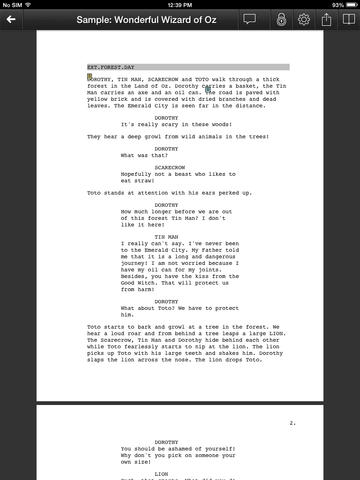

- #CELTX SCRIPT WRITING FOR TV TUTORIAL PDF#
- #CELTX SCRIPT WRITING FOR TV TUTORIAL SOFTWARE#
- #CELTX SCRIPT WRITING FOR TV TUTORIAL LICENSE#
- #CELTX SCRIPT WRITING FOR TV TUTORIAL DOWNLOAD#
#CELTX SCRIPT WRITING FOR TV TUTORIAL PDF#
yes, vim), then using 'afterwriting to convert to PDF for delivery/sharing. Conclusionįor my own process, I've taken to writing my scripts in raw Fountain using a plain text editor (in my case, vim. And the PDFs it generates for delivery are quite clean. It doesn't yet seem to have some of the nice conveniences like remembering scene locations or character names, but it is surprisingly comfortable to write in. It works in any modern web browser and offers more formatting options than Trelby.
#CELTX SCRIPT WRITING FOR TV TUTORIAL DOWNLOAD#
Furthermore, it's very easy to download the whole source and run it locally, offline, on your own computer.
#CELTX SCRIPT WRITING FOR TV TUTORIAL LICENSE#
This node.js application is available under an MIT license and has been seeing very active development on its GitHub page. However, fret not dear open source screenwriter. It is, afterall, a webapp for screenwriting. 'afterwritingĪ quick visit to the website for 'afterwriting (yes, that apostrophe is part of the name) and your internal software-as-a-service alarm bells might be ringing.

However, if you want a proper standalone WYSIWYG screenwriting application, Trelby isn't a bad choice at all. For instance, I'd love to see some more formatting options (like italics text, for example) or an inline commenting system for collaborating (or just leaving notes and reminders for myself). It's still a bit rough around the edges in a couple spots. There's still some light development happening on its GitHub page, and it's still a highly functional open source screenwriting program. TrelbyĪlthough the last stable release of Trelby was in September of 2012, it's not quite dead yet. Plus, as you'll read about next, Trelby and 'afterwriting support Fountain for importing and exporting. So even if you're not writing raw Fountain syntax in a text editor, it's really the best choice of formats for interoperability between screenwriting tools. It's available all over the place, and used in open source and proprietary applications on just about every platform available. Thanks to its open source license and natural syntax, Fountain has seen very wide and rapid adoption. Most of the syntax hints are things screenwriters naturally have already built-in as part of their process. You can tell that it was developed by people who actually write for film and television. The actual process of writing a script in Fountain is surprisingly comfortable if your already familiar with the basic rules of formatting screenplays. You can even get Fountain syntax highlighting extensions for writing in Emacs or vim. This means you can write your screenplay in any text editor that you have available. It's a relatively simple plain text format released under an MIT license.

It's best to think of Fountain as markdown for screenwriting. Who knows? There's always a chance that someone could take the existing codebase and continue development. Interoperability can be a bit of a sticking point, but there are other programs that can read and convert the. those features are all still available and there for you to use. And the convenience functions that maintain note cards and profiles for locations, character names, and even props. The integrated features for planning and organizing your story are useful both in screenwriting as well as writing novels. With the exception of the already mentioned features that connected to Celtx servers, all of the built-in functionality in Celtx still works rather well.
#CELTX SCRIPT WRITING FOR TV TUTORIAL SOFTWARE#
However, the beauty of open source software is that the code is still out there and the program itself is still available for use. Furthermore, it no longer appears to synchronize with the closed source server component (offering cloud storage, online collaboration, and PDF conversion) that the Celtx developers used to maintain. It's true that the open source desktop version isn't seeing any active development. However, we do still have some choices open to us. So, short of creating our own fork, what options are available to those of us who write film, animation, and television scripts, but also care about using open source software? Admittedly, the field has certainly narrowed. The developers of Celtx have been focusing all of their efforts on the web-only, software-as-a-service version of their screenwriting software. I think I was little late to the game in realizing this-after all, the last official stable release of Celtx (the open source, desktop version) was in 2012-but for folks paying attention, it's been a long time coming. While I was putting together slides for my lightning talk at Great Wide Open (happening March 16-17), Not that Weird: Open Source Tools for Creatives, I remembered that in the last half of 2015 we had a bit of a loss from our open source creative toolbox.


 0 kommentar(er)
0 kommentar(er)
